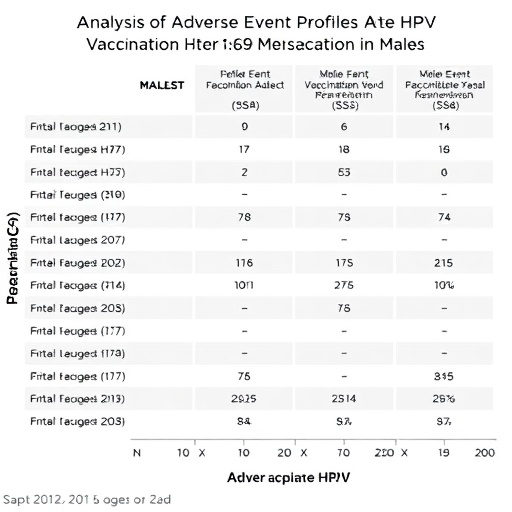The safety profile of human papillomavirus (HPV) vaccination in male recipients has long remained an understudied facet within immunization research, creating a notable knowledge gap despite the vaccine’s widespread use. Recent advances have enabled a more nuanced and systematic assessment of adverse event reports associated with Gardasil and Gardasil 9, two of the leading HPV vaccines administered to males. Utilizing comprehensive data extracted from the U.S. Vaccine Adverse Event Reporting System (VAERS), researchers have shed new light on the occurrence and patterns of adverse events following immunization (AEFIs) in male populations.
This pioneering investigation employed multiple disproportionality analysis algorithms to sift through VAERS data methodically. These algorithms, designed to detect signals of disproportionate reporting, facilitated the identification of positive associations between vaccination and specific adverse events. The approach included repeated cross-validation through four distinct disproportionality methods, enhancing the robustness and reliability of the signal detection process. Such extensive analytical rigor is critical to isolate true vaccine-associated risks from coincidental adverse health outcomes.
Temporal trend analysis further enriched the understanding of vaccine safety by applying Weibull distribution modeling. This statistical technique exposed the temporal distribution of adverse events post-vaccination and enabled estimation of cumulative incidence patterns for both Gardasil and Gardasil 9 recipients. The findings revealed that a significant majority of reports were filed within the first 30 days following immunization, underscoring a critical window for monitoring vaccine safety. Temporal distribution insights also support more targeted clinical vigilance during the post-vaccination period.
Intriguingly, the study revealed distinct safety profiles between Gardasil and Gardasil 9. Gardasil 9 demonstrated a lower cumulative incidence of reported AEFIs compared to its predecessor, suggesting a potentially more favorable safety profile in male recipients. This finding carries substantial weight for public health policies, potentially influencing vaccine recommendations and boosting public confidence in HPV vaccination programs. Such distinctions emphasize the importance of ongoing safety evaluations as vaccine formulations evolve.
Of particular significance is the identification of numerous novel positive signals—20 for Gardasil 9 and 32 for Gardasil—that had not been previously reported. These newly recognized signals expand the existing catalog of possible vaccine-related adverse events, warranting further investigation to ascertain their clinical significance. While the presence of such signals does not inherently imply causality, it provides a crucial foundation for subsequent prospective studies and active surveillance initiatives.
Beyond aggregate signals, the study underscores the necessity for stratified analyses to dissect safety outcomes by age and specific clinical manifestations. Age-stratified risk profiling can elucidate whether certain subpopulations of males are more susceptible to particular adverse events, optimizing patient counseling and post-vaccination care. Outcome-specific evaluations likewise refine understanding of which types of adverse events merit prioritization in safety monitoring.
This research marks the first comprehensive safety evaluation of Gardasil 9 and Gardasil in male recipients, addressing a critical evidence gap that has implications for both clinical practice and public health strategy. The inclusion of male-specific data aligns with an expanding recognition of the importance of protecting all genders against HPV-related cancers and conditions. The evidence presented here strengthens the scientific rationale for widespread male vaccination initiatives.
The practical implications of this study extend to healthcare providers and immunization policy makers. By highlighting a potentially more advantageous safety profile for Gardasil 9 and elucidating the temporal pattern of adverse events, the findings aid clinicians in providing informed risk-benefit discussions with patients and guardians. In turn, this can enhance vaccine uptake and adherence, contributing to broader herd immunity and cancer prevention efforts.
The study was conducted with a commitment to transparency and integrity, with authors declaring no commercial or financial conflicts of interest. This independence strengthens the credibility of the findings and their utility in shaping unbiased public health guidance. Additionally, the use of a large and open-access database like VAERS ensures that the analysis captures a wide range of real-world vaccine safety data.
Future research directions emanating from this work include prospective validation of the identified positive AEFI signals to clarify their clinical significance. Such investigations could involve active surveillance cohorts, mechanistic studies exploring pathophysiology, and integration with electronic health records to confirm incidence and causality. These steps are critical to translate signal detection into actionable safety knowledge.
In conclusion, this landmark study advances the understanding of HPV vaccine safety in males by employing rigorous disproportionality analyses and temporal modeling, uncovering both expected and novel adverse event signals. The data suggest that Gardasil 9 may offer a safer profile than Gardasil, findings that have the potential to enhance vaccine confidence, shape immunization policies, and ultimately contribute to the global effort to reduce HPV-associated cancers.
Subject of Research: Safety profiles and adverse event analysis of HPV vaccination in male recipients
Article Title: Safety Profiles of HPV Vaccination in Males
Web References: http://dx.doi.org/10.1002/imm3.70006
Image Credits: Jingyu Wang
Keywords: Cancer, HPV vaccine, Gardasil 9, Gardasil, vaccine safety, adverse events, immunization




